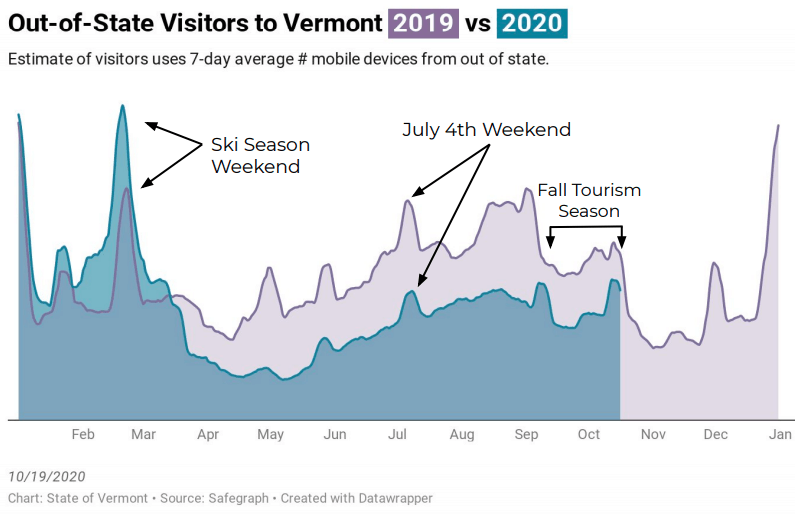
By Erin Petenko/VTDigger
Vermont’s Covid outbreaks have spread past single cases to broader community transmission, contributing to some of the highest case totals the state has had since spring, officials said at a press conference Tuesday, Oct. 27.
An outbreak that began at an ice rink in Montpelier has now infected 57 people, many of whom had little to no contact with the initial hockey and broomball teams that were affected, said state Health Commissioner Dr. Mark Levine.
“What we’ve been experiencing recently are different outbreaks among relatively unrelated groups and individuals, spreading from the original cases, to their contact, and contacts of those contacts, crossing situations and geographic regions of the state,” Levine said.
The ice rink outbreak and several other smaller outbreaks led to one of the highest weekly Covid totals since the start of the pandemic in mid-March. From Tuesday, Oct. 20 to Monday, Oct. 26 there were 157 cases — and for the first time there were new cases in each of Vermont’s 14 counties. Last week’s average daily case count was 22, double what it was last month.

Gov. Phil Scott said the ice-rink outbreak may have begun with out-of-state travel.
Scott reminded Vermonters to obey the state’s travel laws and to be careful with social plans for Halloween this Saturday.
“We need everyone to be smart about any gatherings,” he said. “Before you go, ask yourself: Will people be wearing masks? Is there enough room to spread out? Has everyone been following the travel guide? If the answer to any of these questions is ‘no,’ you should consider skipping it.”
The outbreak stemming from Central Vermont Memorial Civic Center in Montpelier was not connected to actually playing hockey or broomball, but more to the activities associated with sports, such as team activities and carpooling, Levine said.
The 17 primary infectious people then passed the disease along to other people, who gave it to other people — some of whom were already in quarantine, he said.
Small social gatherings, at which people take off their masks to eat or drink, are among factors driving the spread of the virus, he emphasized.
Contact tracers say in the spring people had two or three close contacts, Levine said. Now they have “six or seven or more.”
The forecast: A continuing rise in cases
Vermont’s latest model for the coming weeks shows that Vermont could have 50-60 cases a day by the end of November, according to a presentation by Mike Pieciak, commissioner of the Dept. of Financial Regulation.
But that forecast is not a “foregone conclusion,” Pieciak said. Whether the prediction becomes reality depends on Vermonters’ actions and the precautions they take.
“This has happened numerous times in the past where case growth has gone up, our forecasts have gone up, and Vermonters have responded” in ways that brought the outbreak back under control, he said.
But it’s also worth noting that other states that managed to curb the first wave of the pandemic later had case numbers that rose far past that first wave. Hawaii’s first wave in April topped out at 24 cases per day, then a second wave in August peaked at 309 cases per day.
Pieciak pointed to two metrics where Vermont is doing better than the rest of the nation: its low positivity testing rate and its low hospitalizations.
Four people in Vermont are currently hospitalized for the virus, and its positivity rate is lower than the national average, suggesting that enough Vermonters are being tested relative to the number of cases it has.
Vermont has also not had a single death since July 28.
But bad signs are starting to show up: The case growth rate, measured by new cases day by day and cases are continuing to rise in nearby states. The case totals in the Northeast have risen 21% since last week, the model shows. Fewer people than ever are able to travel to Vermont under the state’s travel map.
Accordingly, the state has issued new recreational sports guidelines that restrict Vermont teams to play games only against other Vermont teams.
Levine said the regional growth trends should also reflected in Vermonters’ holiday plans.
“If Thanksgiving and Christmas don’t look different this year, then perhaps we’re not approaching them correctly,” Levine said. “Because everything we do in our lives this year has looked different in our attempt to keep everything as safe as possible.”
At a press conference Tuesday, Oct. 20, officials reported out-of-staters’ trips to Vermont increased in early October, although fewer visitors came this year compared to fall 2019.
If Vermont were evaluated by its own travel map guidelines, three counties would be in the yellow zone: Chittenden, Bennington and Windsor counties. Scott and Levine urged extra vigilance within communities when rates are high.
“It’s easy to fall into pandemic fatigue. But the virus itself does not tire,” Levine said earlier in the week.
He said he knows many Vermonters will be closely eyeing the numbers in the coming days, but urged them to remember the real people affected.
“They are family members, workmates, classmates, friends, neighbors, or people we only see once in a while,” he said earlier. “But as we discuss these outbreaks and the data, please keep the lives behind the numbers in mind.”



